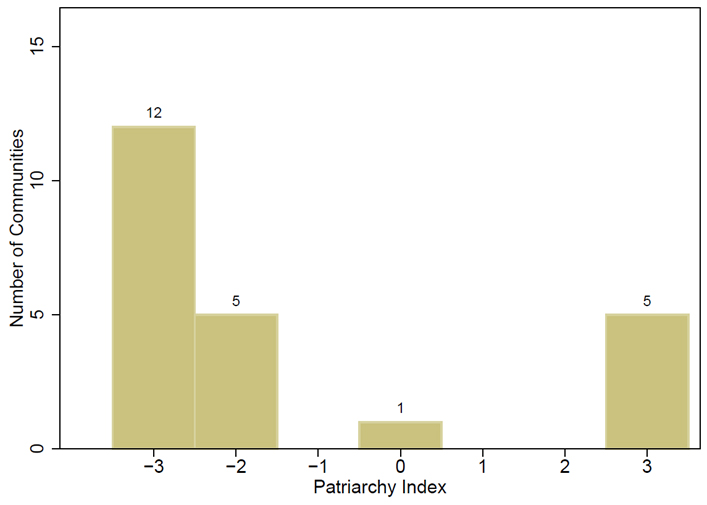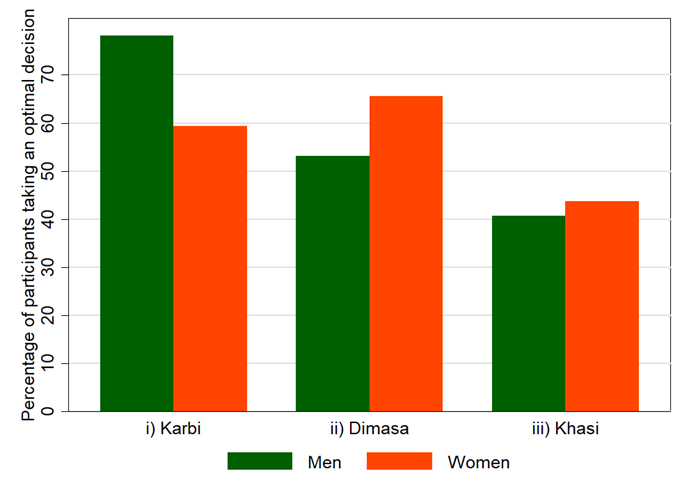The under-representation of women in leadership positions is often attributed to systematic gender differences in the inclination to compete. Do gender-balanced social norms have the potential to close the gender gap in competitiveness in the long run? This article compares the preferences for competition among women and men across societies in Northeast India with varied gender norms.
In most modern societies, women are under-represented in leadership positions in virtually all important segments, including politics, corporates, and academia. A key factor held responsible for this asymmetry across women and men is the systematic difference in the inclination to compete. While a willingness to compete is deemed essential to advance to prominent positions in polities and economies organised around competition, men have been found to opt into competitive environments about twice as often as women in economic experiments (Niederle and Vesterlund 2011). This gender gap has raised the concerns of policymakers and researchers alike, and suggestions for institutional changes to address this range from affirmative action and single-sex education to priming of women with a feeling of power and control in competitive situations.
There is a debate about whether these behavioural differences are primarily attributable to biological differences or to the different social and economic roles that women and men play in society. This discourse is part of a broader ‘nature versus nurture’ debate about gender differences in economic and social behaviour and outcomes. For competitive behaviour, there is some evidence in favour of a biological basis from evolutionary biology and socio-biology (Turkheimer 2004). In contrast, the respective literatures in psychology and sociology tend to support the view that the observed gender differences are primarily a result of a socio-cultural construct of gender and gender roles (Feingold 1994).
Gender gaps in competitiveness in traditional societies
In experimental economics, a groundbreaking contribution to this subject has been the cross-cultural study by Gneezy et al. (2009). They compare women’s and men’s choices to compete in a simple experiment conducted in the field, across two traditional societies1 that are selected so as to differ as much as possible in the social norms ruling women’s and men’s social and economic status. They describe the Maasai in Tanzania as “a textbook example of patriarchal society”. Acknowledging that truly matriarchal societies currently do not exist, they contrast the Maasai with the Khasi of the state of Meghalaya in Northeast India, who practice matrilineage (inheritance and clan membership follow the female lineage) and matrilocality (upon marriage a husband joins the wife’s parental household). Consistent with the hypothesis that patriarchy discourages women and suppresses their economic potential, they find that Maasai men choose to compete about twice as often as Maasai women, while women are more competitive than men among the Khasi. These findings have been corroborated in another study by Gneezy and co-authors (Andersen et al., 2013) on adolescents of the Khasi and Karbi tribes, where the latter are a patriarchal society dwelling in the state of Assam in Northeast India.
Can gender-balanced social norms close the gender gap in competitiveness?
An important open question that remains is whether gender-balanced norms – for which modern societies strive – have the potential to close the gender gap in competitiveness in the long run. We view modern societies in Europe and North America as ones that historically had patriarchal norms, whereas their current norms – at least those codified by law – are gender-balanced. This is in contrast to the above-mentioned studies (Gneezy et al. 2009, Andersen et al. 2013) that compare a society in which both past and current norms are patriarchal, to a society where both past and current norms assign a high social status to women.
To learn more about the effect of gender-balanced norms in the long run, we examine preferences for competition among women and men in a traditional society where both past and current norms are gender-balanced and compare them to the two previously studied traditional societies in Northeast India, the matrilineal Khasi and the patriarchal Karbi (Klonner et al. 2020). With this research design we contribute to the debate on whether the gender gap in competitiveness in modern societies is primarily due to a patriarchal heritage (‘nurture’), or to innate gender differences (‘nature’).
Gender norms among tribes in Northeast India
Our research design comprises two steps. First, we identify a traditional society with gender-balanced norms by systematically coding social norms that are important for women’s status in society for all major scheduled tribes (STs) in Assam and Meghalaya from the ethnographic atlas People of India (Singh 1988). From these data, we construct a ‘patriarchy index’. Figure 1 shows that patriarchal as well as matrilineal and matrilocal societies are relatively common in Northeast India, while societies with balanced gender norms are rare.
Figure 1. Distribution of the patriarchy index

Note: An index value of +3 stands for matrilineage and matrilocality, implying a high social status of women; −3 stands for the opposite and implies a relatively low social status of women; 0 stands for gender-balanced social norms and implies a similar social status of women and men.
Our original objective was to identify a tribe in which women’s and men’s rights and entitlements are symmetric – as in several modern societies. A detailed examination of the social norms in this sample, however, reveals that there is not a single tribe with roughly gender-symmetric norms. Regarding lineage, for example, there is no single case of bilateral descent (a child belongs to her/his mother’s and father’s clan to similar extents) or equigeniture (all children, regardless of their gender, inherit an identical share of parental property, which is the default rule in Indian law). Hence, we focussed on tribes where women and men have similarly important, albeit qualitatively different rights and entitlements.
Among the 26 STs whose norms we code, there is only one tribe with a patriarchy index of zero – the Kachari-Dimasa of Assam. This society is duolineal, meaning that a son belongs to his father’s clan and a daughter to her mother’s clan. There is male equigeniture for paternal properties, which comprise agricultural assets and real estate, female equigeniture for maternal properties, which include clothes, jewellery and looms, and equigeniture for household public goods such as furniture and kitchen equipment. Finally, the Dimasa practice neolocal residence, meaning that a couple establishes a new residence after the birth of the first child. For comparison the Karbi, who live adjacent to the Dimasa, practice male primogeniture (the first-born son inherits all property), patrilineage (all children belong to their father’s kin), and patrilocality (at least the oldest son stays with his parents and is joined by his wife), while the Khasi practice female ultimogeniture (the last-born daughter inherits all property), matrilineage and matrilocality, wherein at least the youngest daughter stays with her parents and is joined by her husband.
Using experiments to study competitiveness
We conducted competition experiments with 192 persons (96 women and 96 men) of the Dimasa, Karbi, and Khasi tribes. In this experiment, a participant is rewarded for successful tosses of a ball into a bin. Before tossing, the participant chooses whether her or his reward shall depend on her/his own successes only (at a rate of. Rs. 10 per successful toss) or whether he or she competes and earns three times the reward of the non-competitive scheme – but only if he/she succeeds more often than an anonymous competitor from the same tribe.
As depicted in Figure 2a, our experimental results support the hypothesis that gender-balanced norms remove gender gaps in competitiveness. While men compete almost twice as often as women among the patriarchal Karbi, this gender difference melts down to 18% among the Dimasa that have balanced gender norms, while women compete 13% more often than men among the matrilineal Khasi.
Figure 2a. Percentage of women and men who chose to compete, by tribe
To assess whether patriarchy leads to worse economic outcomes for women through their choices and whether gender-balanced norms have the potential to remove this asymmetry, we also analyse the optimality of choices. According to Figure 2b, we find that women among the patriarchal Karbi compete too little, making choices that maximise their payoffs 33% less often than men. In contrast, among both Khasi and Dimasa, where more female competitiveness is observed, women’s choices are payoff-maximising more often than men’s.
Figure 2b. Percentage of women and men whose decisions turn out to be optimal, by tribe

Note: ‘Optimal’ indicates that a participant’s choice between the piece rate and the competitive remuneration scheme maximises her/his payoffs given her/his number of successful tosses.
From ‘equality under the law’ to ‘equality in competitiveness’
Our experimental results confirm that patriarchal norms suppress women’s economic potential by making them compete too little. In addition, gender-balanced social norms – rather than the extremity of matrilineage and matrilocality – effectively remove gender asymmetries in behaviour and economic outcomes. In the traditional society with gender-balanced norms that we have studied, the gender difference in competitiveness is much smaller than in several experiments conducted in modern societies of Europe and North America (Niederle and Vesterlund 2011). This result supports the view that historical norms and institutions strongly impact contemporary behaviour, specifically that a legacy of patriarchy in modern societies is primarily responsible for the stark gender differences in competitiveness.
For societies whose objective it is to close this gender gap, our findings underline, first, the importance of social norms as these are practiced rather than provisions toward gender equality that are merely legally sanctioned. Second, they stress the importance of long-term effects of social norms and institutions – while women’s rights have improved significantly in western countries over the last 200 years, contemporary gender patterns in competitiveness as elicited by economic experiments continue to resemble those in traditional patriarchal societies (Niederle and Vesterlund 2011, Gneezy et al., Andersen et al. 2013). In contrast, in the tribe with gender-balanced social norms that we have studied, both past and current norms are roughly gender-balanced – and women compete almost as often as men.
I4I is now on Telegram. Please click here (@Ideas4India) to subscribe to our channel for quick updates on our content.
Notes:
- For this study, our concept of a “Traditional society” is that past and current gender norms are congruent, while past and current gender norms differ in modern societies
- That more than 200-year-old historical norms and institutions, even if long overcome, greatly affect contemporary behaviour has been shown by Nathan Nunn and co-authors in numerous recent studies for many domains of economic and social behaviour (Nunn 2020).
Further Reading
- Andersen, Steffen, Seda Ertac, Uri Gneezy, John A List and Sandra Maximiano (2013), “Gender, competitiveness, and socialization at a young age: Evidence from a matrilineal and a patriarchal society”, Review of Economics and Statistics, 95 (4): 1438–1443. Available here.
- Feingold, Alan (1994), “Gender differences in personality: a meta-analysis”, Psychological Bulletin, 116 (3): 429 - 456.
- Gneezy, Uri, Kenneth L Leonard and John A List (2009), “Gender differences in competition: Evidence from a matrilineal and a patriarchal society”, Econometrica, 77 (5): 1637–1664, Available here.
- Klonner, S, S Pal and C Schwieren (2020), ‘Equality of the Sexes and Gender Differences in Competition: Evidence from Three Traditional Societies’, Alfred-Weber-Institut Discussion Paper No. 675.
- Niederle, Muriel and Lise Vesterlund (2011), “Gender and competition”, Annual Review of Economics, 3(1): 601-630. Available here.
- Nunn, Nathan (2020), “The historical roots of economic development”, Science 367 (6485).
- Singh, KS (1988), People of India (National Series): India's communities, Oxford University Press, New Delhi.
- Turkheimer, E (2004), ‘Spinach and ice cream: Why social science is so difficult’, In L Di-Lalla (Ed.), Behavior genetics principles: Perspectives in development, personality, and psychopathology.




 24 November, 2020
24 November, 2020 







Comments will be held for moderation. Your contact information will not be made public.